WASHINGTON, DC
December 2, 2010
STRANGER: Paul Roe
LOCATION: Montmartre, 327 17th Street SE, Washington, DC
THEME: Talking about tattoos
Perhaps it was the fact I was having dinner with a tattoo artist, or perhaps it was the fact that I had some Frank Sinatra songs on shuffle on my iPhone that night, but I couldn’t shake the song “I’ve Got You Under My Skin” during my latest dinner interview.
I even thought about making that the title for this article after Paul, 42, summed up the basics of his work in four words: “I’m in your skin.”
But there’s far more to Paul’s work than the stereotypical image of a tattooist sitting in some grim store selling easily reproducible tattoos such of skulls, crossbones, Celtic armbands and so on. Because Paul is a self-described “haute tattooist.” Each image he creates is unique to the person receiving it, and he never repeats a design.
As is par for the course I was running late for the interview, which took place at a French restaurant called Montmartre in Washington DC’s Capitol Hill neighborhood.
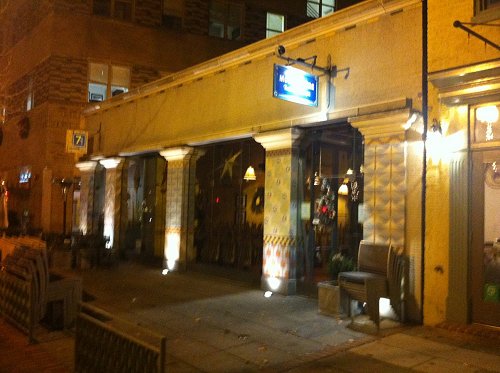
Paul was already at the table, dressed entirely in black, covering up arms that I would later see being etched with incredibly detailed, impressive tattoos. Born and raised in England, Paul is a well-spoken guy with a deliberate pattern of speaking, intelligent and careful but with a few quips thrown in here and there. Plus, as a fellow Brit, it was nice to hear a proper English accent.
“I was born on a dark and stormy night,” Paul said. It was 1968 and he was born on a Royal Air Force (RAF) base in Wanstead, Berkshire. Paul’s father was in the RAF and so the family moved a fair amount before settling in 1977 in Norwich, England.
Paul always had an interest in art and design, so after leaving school he went to the Great Yarmouth Institute of Art of Design “which is sadly no longer with us.” There he learned about fashion and graphic design. Back then there was no computer design, everything Paul did was hand-made, which gave him a strong grounding relying on his own hand to draw, rather than a machine.
After graduating from college Paul decided that graphic design would be a “nice, easy way to make a living.” He found work with a graphic designer in Norwich, where he learned to typeset everything by hand. Paul said he easily picked up graphic design and found it simple crafting corporate logos and the like.
But the industry didn’t pay that well, so to supplement his income with something he enjoyed, Paul started work as a waiter. “My mother was a chef, so I spent most of my childhood growing up in the kitchen,” he said. Paul’s mother was a Spanish gypsy from Valencia, and Paul was schooled from an early age in Mediterranean cuisine. The Roe family would also spend summers at a relative’s house in the south of France, where Paul quickly learned to love fine fresh food and good wine.
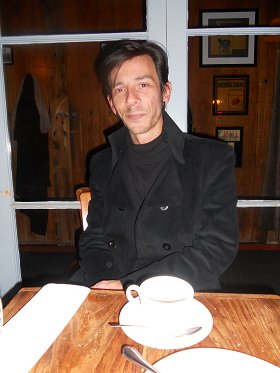
“From a very early age food and wine was ingrained in me, and it was very easy to step into the restaurant atmosphere,” he said. The career in the food industry saw him working at a couple of “very good” French restaurants in Norwich.
But in his 20s Paul was getting bored with life in Norwich. His sister was working in the tony Washington, DC, neighborhood of Georgetown as a governess, and had an apartment she wasn’t using. So Paul packed a suitcase and got on an airplane, originally intending to stay just five months for what he described as a “drying out period.”
After a few weeks of sightseeing, he was bored again. So he picked up a newspaper and scoured the personals. Spotting an ad for a woman into “weird movies and fun stuff,” Paul rang the number and left a message. The woman, Regina, called him back and they spoke for two hours. They clicked instantly, and six months later they were married.
It was now early 1992. The couple wanted a change of pace and so they moved to New York City. Paul kept working in the restaurant industry. He worked in “many wonderful restaurants” though his wife wasn’t enjoying her new job with the city comptroller’s office. “Corruption abounded, and she doesn’t work like that,” Paul said.
Then the couple found out they were going to become parents to a boy, Kane, and decided that a 600-square-foot apartment in New York City was not the place to raise a child. They moved back to Washington, where Paul continued to work in the restaurant industry.
>Paul’s love of fine dining is the reason he picked Montmartre for dinner.
Often these dinner interviews take me to restaurants I’ve never tried before. Can’t say the same about Montmartre. During the last few years it’s become my go-to fine dining spot in Washington. The service is friendly and attentive, and the prices are just about right for the high quality of food. Everything I’ve tried has always been delicious.
The meal with Paul proved to be no exception.
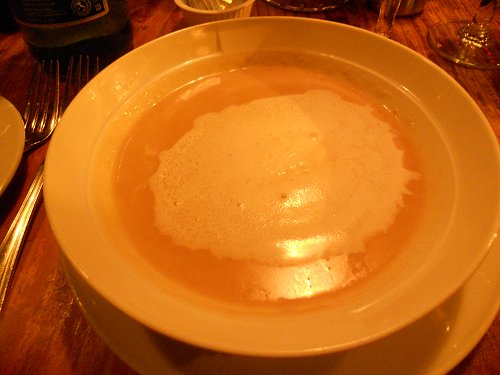
For starters we both went for the creamy chestnut and bacon soup for $8.95. Delicious. Served piping hot, the soup might not look like much in the above picture but it was excellent, a subtle flavor that was very moreish, to the point of me dabbing bread into the bowl to get the last drops.
Paul and I both agreed on the excellent quality of the soup, and as we made our way through the first course, the conversation about our meal led naturally back to his mini biography, picking up where it left off in Washington.
As he neared his 30th birthday, Paul noticed busboys pushing 60 and decided, “There’s no way I’m going to be a lifer in the fine dining business.”
While he pondered how to return to his love of art, Paul was also contemplating getting a tattoo to celebrate his son’s birth and as a symbol on his body to affirm “that I am well.”
Paul had already gotten one tattoo, when he was 17. It’s of a Japanese bat flying out of the horizon, which was the symbol of his dojo, or training place, for kendo — a martial art of sword-fighting. Getting that tattoo was a sign of commitment to his dojo, he said.
The 30th birthday tattoo was more reflective, with Paul considering a Celtic pentagram that he said reflects a sense of family and his desire to “stand strong” like the Celts.
But Paul didn’t want a generic Celtic pentagram. So he started sketching with Celtic imagery, and took his design to a tattoo shop. The tattoo artist liked the images so much he asked to keep them, and did so as part-payment for inking Paul’s skin. Roughly six months after getting the tattoo, Paul got a call from the same artist saying he felt guilty making money off the design. “He asked me what I wanted, and I said, ‘Teach me.'”
“The tattoo industry is very transitional”
So it began. Paul started in the tattoo industry as an unpaid “shop bitch” making needles and stencils and so on, while also working at restaurants to earn money.
Paul did a lot of research into tattoos — something that would become obvious given his many stories on the history of tattooing that he shared during dinner. After 18 months he was given a tattoo machine and told to pick a design and put it on his own skin. That’s a “very traditional” rite of passage for a fledgling tattoo artist, Paul said. “If you can make the mental separation between applying the image and receiving the image then you’re almost ready to start tattooing someone else.” His boss saw Paul’s finished tattoo, and said, “You start work on Saturday.”
Regina was now working for the Government Accountability Office in Washington (then known as the Government Accounting Office), so the family had health insurance. That meant Paul could pursue a career as a self-employed tattoo artist.
His first place of work was a walk-in street shop that did its “meat and potatoes” work selling flash tattoos. Rank in these places is based on one’s time of service, and so Paul as a newcomer was the “low man on the totem pole.” But the tattoo industry is “very transitional” given the widespread popularity of tattoos, and people soon left the shop allowing Paul to rise in seniority.
Why is tattooing such a transient industry? Paul said it’s because there’s a tattoo shop “everywhere. Every indigenous group of people on this planet have tattoos. It is innately human that we decorate ourselves.” The ubiquitous nature of tattooing, combined with the lack of language barrier — communication can be entirely through pointing at artwork and where to put it on the body — makes it an industry rife for high turnover at shops, with tattooists traveling the globe, he said.
“People know me as ‘British Ink’”
That transience meant that after three years at the shop he was head artist, even though people below him in seniority might have had much more experience in the industry.
From there Paul got a job at a tattoo shop called Black Ink in Washington. People would come in with a generic idea for a tattoo, and Paul would pitch to them that for a little more money he could draw them a unique design. “It’s yours, nobody else has it, put it on, I tear up the design.” The individual artwork proved popular and word of mouth quickly spread. “People would come in to the shop and say, ‘I want to speak to English.’”
Eventually the other artists in the shop would be sitting around with nothing to do while Paul serviced a long list of clients. “Why? Because I was offering something unique.”
Paul soon started to plan opening his own place, seeing the “dawning of the custom tattoo. No longer do you have to have what’s on the walls of a shop, because we’ve got artists around. We can take a basic premise and make it whatever you want.” For example, say a customer wants a dragon tattoo. Paul reeled off a long list of questions. “What type of dragon? European? Asian? What type of tendrils? Eyes? Coloration? What do you like? Ultimately it’s going to be on you.”
Paul’s first shop was near Catholic University in Washington. A small 5,000-square-foot place, Paul christened it British Ink. He said, “I thought about all sorts of stupid names to call my studio but I just kept coming back to British Ink because this is what people know me as” because he’d used the name as a moniker on two online tattooing forums, The Read Street tattoo forum and Tattoodles.
Business was good, but after four years Paul was ready for some coworkers. “It was very insular working alone, there was nobody to bounce ideas off. It was depressing.”
“My prodigy has to know everything I know and then some”
So he moved to a new location that would allow him to hire some independent contractors. He found the second floor of a building at 508 H Street Northeast. He’s been there ever since. “It’s perfect. It doesn’t need to be street level because we’re not a walk-in shop.”
The first coworker he took on was Cynthia Rudzis, a tattoo artist from Maryland. Paul had followed her work on the Tattoodles forum. Cynthia was inking single-line skulls and other flash images and “fucking hated it,” Paul said. After meeting with Paul at the British Ink studio, she was sold on the haute tattoo concept and jumped on board.
Cynthia took on an apprentice named Robie Sayan, who Paul described as “a very technical tattooist. He’s extremely precise. He’s wonderful.” Robie recently launched his own company making custom tattoo machines. “His approach to machines is my approach to custom tattoos,” Paul said.
For about a year Paul has also been working with his first-ever apprentice, Liaa Walter. She is a “phenomenal artist and an amazing people person.” Paul said he’s been impressed with Liaa’s work. “I’m passing on my knowledge, my prodigy has to know everything I know and then some. The student has to exceed every expectation that the teacher has, and she’s doing that.”
To spread the word of their services, the British Ink crowd has worked a semi-annual DC event called Artomatic. It’s clearly something dear to Paul’s heart, because he spoke animatedly as he recalled past Artomatic shows where British Ink took center stage. For example, in 2004 he did his first appearance at the event tattooing people in front of an audience. “It was packed every single day and every single night. I was the one exhibition that was consistently drawing a crowd.”
At another Artomatic event, Paul and Cynthia took a “steam-punk” concept from the Victorian dawn of the tattoo industry, building a Victorian tattoo parlor with an absinthe bar, fainting couch, chandeliers and red velvet curtains. The “exquisite” display drew thousands of visitors, Paul said. “Marketing that way, to me, trumps any kind of print marketing.”
I wanted to find out more about Paul’s approach to custom tattooing, but before I could continue with my line of questioning, the waiter came over with our main courses.
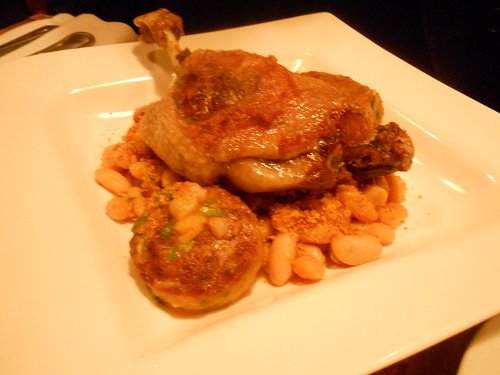
Paul went for the $20.95 duck leg confit over cannellini beans, garlic and Toulouse sausages. I didn’t try of it, but here are some words Paul used to describe it: delicious, fantastic, and amazing.
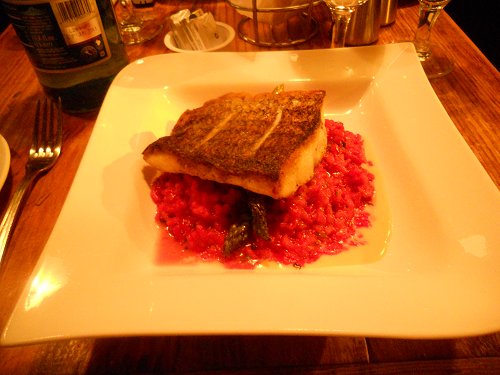
I opted for a special of sauteed rockfish with red beet risotto, asparagus, and white wine sauce. It was well worth the $21.95 price tag, with a massive slab of perfectly cooked fish sitting atop an avalanche of risotto. The fish was moist and covered in a tangy sauce. The red beet risotto was outstanding and so generous in size I couldn’t finish it.
As I made my way through the main course, I asked Paul to explain more about his approach to tattooing. In the process, I feared earning his wrath for peppering him with questions and making him talk rather than being able to savor his meal.
His philosophy is simple. “It’s got to fit you,” he said of tattoo designs. Harking back to his college work, he said, “I’m a dresser, I view the image in context. The frame is your shape, where on the frame it goes will depend on the flow, the composition of those elements. The size, the detail level, all are going to affect the final finished image and its longevity.”
Paul also puts the same level of care into tattoo machines that he makes. Pulling out his phone, Paul showed me a series of impressive pictures of his self-made tattoo machines, including one decorated with Veuve Clicquot champagne labels. “I’m known for doing very high-end finishes,” he said. But true to his artistic ideals, he said he’ll never sell a machine.
Likewise, Paul doesn’t sell his designs. He sells the process of inking a unique image onto someone’s skin and providing a full aftercare package. But he keeps his art’s copyright.
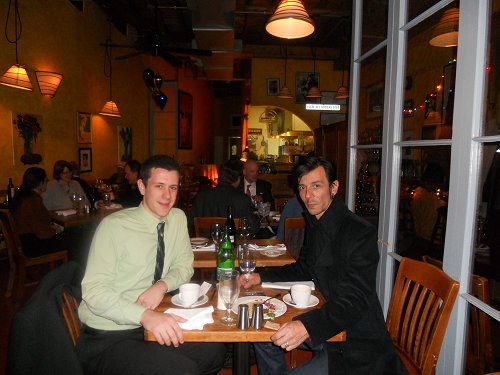
“All my clients sign copyright agreements because I maintain the copyright to protect the interests of my client. It’s my responsibility to protect that image, protecting my clients and keeping that image exclusive to them. It’s not a work-for-hire agreement. If you want to buy the design, go ahead, but you’ll be charged for the design,” Paul said, visibly irritated by the idea of copyright theft.
Seems there is reason for his irritation. His images have been ripped off before. He once saw a guy in New York City walking down the street with a t-shirt featuring a Paul Roe design. Paul asked the man where he got the t-shirt, and he said it was being sold by a DJ. Turns out that DJ had visited Paul five years ago to get the tattoo. “And now he thinks he owns it. Guess what? I still own it.”
Paul said he hasn’t yet had to sue a client — maybe he couldn’t track the DJ down? One reason for the lack of litigation is that “we very carefully pick and choose” the clients at British Ink. “Also, the old school mentality in tattooing is that if you take one of my designs and put it on someone else, if I find out, I’ll take it back. I’ll literally take it back,” he said, conjuring up a rather gruesome image in my mind of him following through on the threat to take back a tattoo from someone’s skin.
Theft of images isn’t condoned in the industry, and anyone who steals designs will find themselves out of business quickly, Paul added. “Part of the thumbcutter’s union code.”
“I have fun with tattoos, that’s the key”
So how does Paul feel about Don Ed Hardy, a famous tattoo artist who made a deal for his images to be sold on T-shirts? Paul said that Don’s son Doug is a good friend and also a moderator on the Read Street forum. Paul has no problem with Hardy’s deal to sell his images for replication. That’s his choice. What he has a problem with is the illegal reproduction of Hardy’s designs on vodka bottles, perfume containers, hair curlers and the like. “Ed Hardy isn’t making money off that.”
Despite his concern about copyright theft, Paul said that he is as excited about tattooing today as when he first started working with skin and ink more than a decade ago.
Part of the excitement is learning new information about the history of tattoos, he said. “I’ve done many things in my life but never have I been in a situation like with tattoos where I can say I’ve been doing this for 13 years and I know shit. I might know 100 times more than the guy down the road but there is so much more to learn” about the world of tattoos.
For example, Paul wrote a paper about eight years ago after finding a twin-coil modern tattoo machine at a museum in London. It showed that the British had the machine configuration at least 30 years before the first twin-coil machine introduced in America. That kind of historic surprise about tattooing — still possible after all these years — appears to fascinate Paul.
Our conversation was interrupted once more by the waiter, though not rudely. The staff at Montmartre are impeccably mannered, and friendly without being over-familiar. Our waiter showed us a tray of desserts, including lemon pie, a berry tart, and others. I was too full for anything, but Paul went for a chocolate tart.
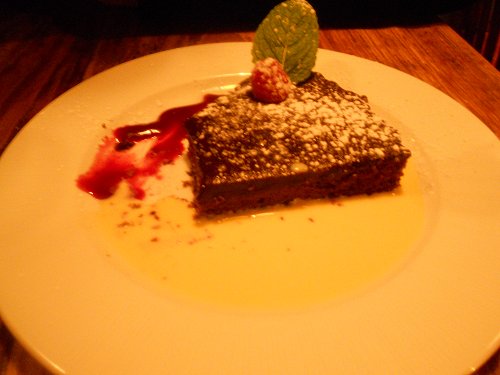
I think I was a little too engrossed in the conversation, because I forgot to take a photo of the tart before Paul dug in. Regardless, you can see it above in its half-consumed glory. As with everything else on the menu that we tried that night, Paul said it was delicious.
As he polished off his dessert and we closed out dinner with some coffee, Paul said that in addition to finding out more about the rich history of tattoos, there’s another reason he loves his work. “I have fun with it, that’s the key. I’m not just doing it because it’s a job, but because it’s a passion. It changes people physically and mentally,” he said.
That approach also means he can be selective in the clients he takes on, and can shun people who are simply looking for tattoos of a spouse’s name or an elaborate design in an impossibly small area of skin.
“Many tattoos I will turn down because they’re unrealistic. Somebody wants so much inside such a small place. It will look great, but in six months’ time it will be a puddle of shit and my name’s still attached to that, so it’s not going to happen,” Paul said.
As for getting a spouse’s name tattooed? “Go somewhere else. A blood relative is never going to change. But the kiss of death to any relationship is having that person’s name tattooed on you. You explain it to the client and they understand and most of the time they’ll thank you for it.”
More generally, Paul won’t rebuff a request for a design based on the image itself. “One person’s offensive symbol is another person’s religious symbol. It’s so open to individual interpretation. Mine is not to judge, mine is to apply. Have whatever you want on your body. It’s your body. But it’ll be put on there the correct way and you’ll pay for it.”
“I want to be tattooing in 40 years’ time”
Paul said if people ask him what design they can have, he responds that their tattoo hasn’t been made yet. “We’ll do a consultation, sit down, sketch it out and make a pattern of the area, so I can lay it out. On there is the bone structure, the muscle structure, the tendons, so I know when this image moves exactly how it will move. It has to work with the body. The difference between a good tattoo and an amazing tattoo can be one quarter of an inch rotation to the left.”
Does he have a favorite tattoo? “The one I’m working now,” he said, referring not to his latest design, but the fact he’s entirely focused on whatever his latest project might be.
In addition to brand new designs on clean skin, British Ink offers “smoke and mirrors” cover-ups of both crappy tattoos done elsewhere or to cover-up extensive scarring. He’s been working for 18 months with a man who has extensive scarring on both arms, finally agreeing on a wisteria design to cover up the scars. Paul’s been delighted with the cover-up work. “I literally changed his life. He has a different outlook on who he is as a person, now he wants to show his arms off. He’s proud.”
Paul is also proud of the work, and of his shop, drawing parallels between his work in tattooing and his love of fine dining. “You ask, ‘how much is a tattoo’? That’s like asking how much is dinner? What do you want? You go to Wendy’s and for five bucks you can eat. You go to Montmartre and it’s considerably more, but you get what you pay you.”
The same logic applies to Paul’s tattoos. “My customers have my time from the second they walk in to the second they walk out. You’re paying me for my time. I’m going to extend the courtesy of giving you my time, my full attention and the utmost in concentration because I’m changing your body. I’m in your skin. You as a customer deserve that respect.”
Paul said, “My reputation walks out the door with every tattoo that I do, that Liaa does, that Cynthia does, that Robie does. I want to be around tattooing in 20, 30, 40 years’ time, I want my clients still to roll their sleeves up and say, ‘Check this out, he’s a little shaky, but he’s still working.’”
qmg52w